On Monday afternoon we received a call for a horse on the wrong side of the river in Snohomish. We sent out a responder who lives in the area to have him evaluate the situation and take some photos so we could figure out if we could do a safe rescue and if so, how we’d do it.
The horse, Twix, was on the far bank and safe but hemmed in by geographical features and too afraid of the water to make it through on his own.
As we try to avoid doing operations in the dark, we decided the horse was safe enough for the evening and the owner was satisfied there was enough grass for him to graze until we could help him the next day.
That evening we considered and rejected a number of plans. Our plan A is always to find a way to allow the animal to rescue itself. Plan B is to walk the animal out if we can. The rest of the plans are varying levels of complexity and danger, and safety of everyone and every animal involved is our number one concern.
Though the river is low, any water rescue can be dangerous, and we assumed it was safest to treat this as a swift water rescue. Swift water is not something we are trained in, so it is not something we’d attempt on our own.
We called our friends at Summit to Sound Search and Rescue in Whatcom County. We’ve worked with them a number of times and had a swift water rescue with them not too long ago. Additionally, a number of their swift water technicians are also horse people so they’d have an idea of the added danger of having a horse involved. Snohomish County’s Sheriff was kind enough to put in an official request for Summit to Sound and four responders came down that afternoon with a boat and equipment in tow.
We met in the afternoon on the opposite side of the river, about half a mile up stream from the horse. Joining us was Dr. Dana Bridges Westerman and some friends who also brought boats.
We put on life jackets and helmets and headed down the river. Though most of the river was low enough to walk through, there was a channel right in front of the horse that was about ten feet wide and seven feet deep. This was the main feature we needed to get the horse through to get him to safety.
Two responders and Dr. Dana boated across. One of our best horse handlers, JC, rigged the horse with a configuration called a Wideman Configuration. The strap is pretty wide to distribute weight and not cut the horse, and the loop it makes keeps the horse securely harnessed while it is pulled forward.
We attached a water rescue rope to the rigging on the horse. The water rescue rope is key here because it’s designed to float and have less drag in the water where our usual climbing ropes would have bogged down and become a potential hazard. and Dr. Dana had an inner tube she put around the horse’s neck to give it a little extra floatation to keep the head above water should he need it. She also gave the horse a bit of sedation to help with the horse’s fear of the water.
Even floating, the contact with the water would have made the rope harder to pull because of drag and the swift water team determined the best place for them was holding the rope up out of the water.
The rest of the responders took their places on the other end of the rope to pull the horse into the water and through the deeper part so he could just walk the rest of the way over. Nearby, his owner, her friend, and Twix’s pasture-mates were on hand to call him over and encourage him.
Rigging lead Joe called the pull and we steadily and firmly pulled Twix off his spot by the side of the river, into the water, and across the river.
The solution worked well and his nose never went under, which could have caused medical issues. We’re really grateful to Summit to Sound for lending us their swift water experts. They are to thank for the rescue going safely and smoothly. Had it not they would have been even more invaluable in adapting plans. We’re also very appreciative of Dr. Dana and her friends from Rotten Chum Guide Service for the operation and use of their boats.

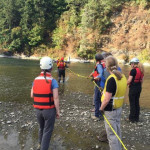

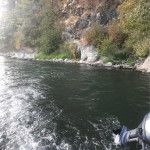
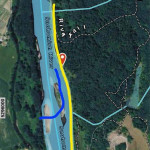
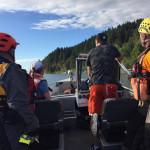

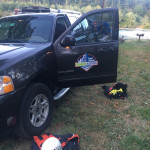
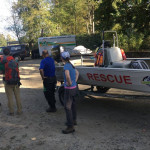
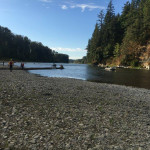
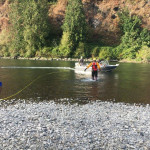
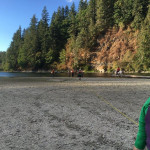
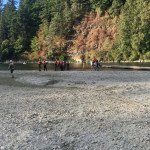
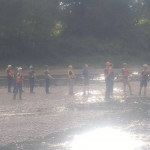
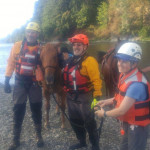
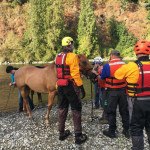
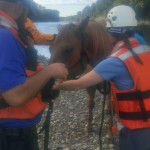
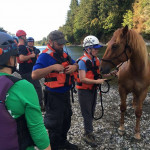
 Buster: Horse Needing a Lift
Buster: Horse Needing a Lift